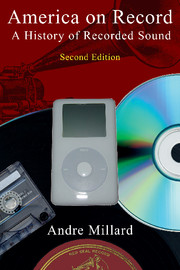Book contents
- Frontmatter
- Dedication
- Contents
- Preface to the second edition
- Preface to the first edition
- Introduction
- Part One The acoustic era
- Part Two The electrical era
- Part Three The digital era
- 16 The media conglomerates
- 17 Into the digital era
- 18 Consolidation and connectivity in the digital era
- Abbreviations used in the notes
- Notes
- Select discography
- Select bibliography
- Subject index
- Recordings index
- Motion picture index
18 - Consolidation and connectivity in the digital era
from Part Three - The digital era
Published online by Cambridge University Press: 05 February 2015
- Frontmatter
- Dedication
- Contents
- Preface to the second edition
- Preface to the first edition
- Introduction
- Part One The acoustic era
- Part Two The electrical era
- Part Three The digital era
- 16 The media conglomerates
- 17 Into the digital era
- 18 Consolidation and connectivity in the digital era
- Abbreviations used in the notes
- Notes
- Select discography
- Select bibliography
- Subject index
- Recordings index
- Motion picture index
Summary
The successful introduction of the compact disc strengthened the grip that a few large companies held on the global entertainment industry. The new technology had emerged from their research laboratories, and its application was directed by the corporate strategies of control and consolidation. Marvelous new technologies which offered superior performance but could not be altered by the user were ideal products for the Empires of Sound. Like their other winning audio formats – 78-rpm shellac discs and 33-rpm vinyl records – CDs were read-only and could not be rerecorded. The new digital disc was the ideal weapon to fight unauthorized taping of copyrighted music because audio cassettes now sounded vastly inferior to digital reproduction. The CD was also expected to inject new life into a flat market for popular music in the 1980s as consumers were expected to make large outlays to replace their aging vinyl and cassettes with expensive digital discs.
The compact disc was the vanguard of the next generation of leisure time products based on the digital transmission and reproduction of sound. A common technological foundation made it easier to group several kinds of entertainment into one business organization. Digital sound technology was to be the platform for bigger and more diverse media conglomerates; it became the building block of several new entertainment empires.
In the record business, the policy of consolidation was almost as old as the acoustic technology that made sound recording possible. The Empires of Sound had always eaten up smaller competitors, and this feeding continued at a faster pace in the digital era. The majors were omnivorous, swallowing up the old independent record companies, which had valuable catalogs of sixties music, such as Chess (bought by MCA) and Motown and A&M (taken over by Polygram). They also took over the newer labels that had a finger on the pulse of contemporary culture. Every new wave in American popular music – however alienated and disaffected – was effortlessly incorporated into the system and its energy harnessed.
- Type
- Chapter
- Information
- America on RecordA History of Recorded Sound, pp. 367 - 408Publisher: Cambridge University PressPrint publication year: 2005

